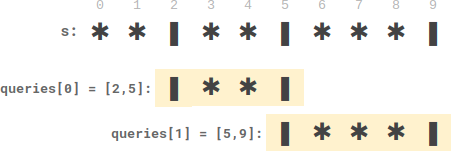Plates Between Candles
There is a long table with a line of plates and candles arranged on top of it. You are given a 0-indexed string s consisting of characters '*' and '|' only, where a '*' represents a plate and a '|' represents a candle.
You are also given a 0-indexed 2D integer array queries where queries[i] = [lefti, righti] denotes the substring s[lefti...righti] (inclusive). For each query, you need to find the number of plates between candles that are in the substring. A plate is considered between candles if there is at least one candle to its left and at least one candle to its right in the substring.
- For example,
s = "||**||**|*", and a query[3, 8]denotes the substring"*||**|". The number of plates between candles in this substring is2(at indices6and7), as each of the two plates has at least one candle in the substring to its left and right.
Return an integer array answer where answer[i] is the answer to the ith query.
Example 1:

Input: s = "**|**|***|", queries = [[2,5],[5,9]]
Output: [2,3]
Explanation:
- queries[0] has two plates between candles.
- queries[1] has three plates between candles.
Example 2:

Input: s = "***|**|*****|**||**|*", queries = [[1,17],[4,5],[14,17],[5,11],[15,16]]
Output: [9,0,0,0,0]
Explanation:
- queries[0] has nine plates between candles.
- The other queries have zero plates between candles.
Constraints:
3 <= s.length <= 105sconsists of'*'and'|'characters.1 <= queries.length <= 105queries[i].length == 20 <= lefti <= righti < s.length
Solution
To find the number of plates for each query (qleft, qright), we set up an array candles to store the candles' indices, so that we could later do basic arithmetic on the indices to find the number of plates.
First, we need to find the outside candles' indices in the input s, this can be done via binary search in candles. We will find left_pos and right_pos indicating the outside candle's position in s.
Then, We know that the number of plates is given by the interval between the two bounding candles subtracted by the number of candles in between.
With the indices left_pos and right_pos, we can derive the number of plates to be (candles[right_pos] - candles[left_pos]) - (right_pos - left_pos).
Implementation
def platesBetweenCandles(s, queries):
candles = []
for i in range(len(s)):
if s[i] == '|': candles.append(i)
res = []
for qleft, qright in queries:
left_pos, right_pos = -1, -1
# 1. find index of first candle that comes after qleft
left, right = 0, len(candles)-1
while left <= right:
mid = (left+right) // 2
if candles[mid] >= qleft:
right = mid - 1
left_pos = mid
else:
left = mid + 1
# 2. find index of last candle that comes before qright
left, right = 0, len(candles)-1
while left <= right:
mid = (left+right) // 2
if candles[mid] <= qright:
left = mid + 1
right_pos = mid
else:
right = mid - 1
# result = range between two outermost candles - candle count in between
if (left_pos != -1) & (right_pos!= -1) & (right_pos > left_pos):
res.append((candles[right_pos] - candles[left_pos]) - (right_pos - left_pos))
else:
res.append(0)
return res
Intuition
Instead of counting the number of plates between two indices, which takes O(n) time, we can use the indices of the candles to figure out the number of plates between the candles (store in candles).
Ready to land your dream job?
Unlock your dream job with a 5-minute evaluator for a personalized learning plan!
Start EvaluatorWhich of the tree traversal order can be used to obtain elements in a binary search tree in sorted order?
Recommended Readings
Coding Interview Patterns Your Personal Dijkstra's Algorithm to Landing Your Dream Job The goal of AlgoMonster is to help you get a job in the shortest amount of time possible in a data driven way We compiled datasets of tech interview problems and broke them down by patterns This way
Recursion If you prefer videos here's a video that explains recursion in a fun and easy way Recursion is one of the most important concepts in computer science Simply speaking recursion is the process of a function calling itself Using a real life analogy imagine a scenario where you invite your friends to lunch https assets algo monster recursion jpg You first call Ben and ask him
Runtime Overview When learning about algorithms and data structures you'll frequently encounter the term time complexity This concept is fundamental in computer science and offers insights into how long an algorithm takes to complete given a certain input size What is Time Complexity Time complexity represents the amount of time
Want a Structured Path to Master System Design Too? Don’t Miss This!
